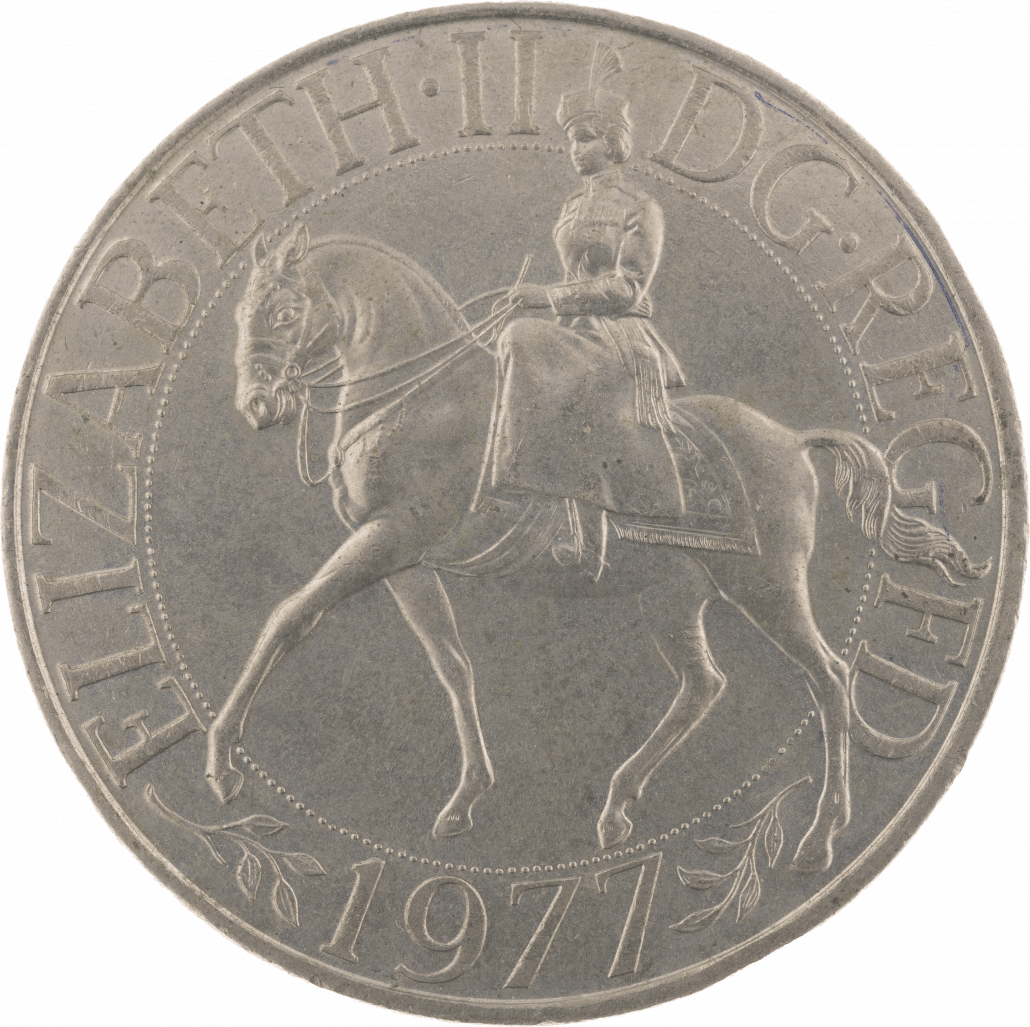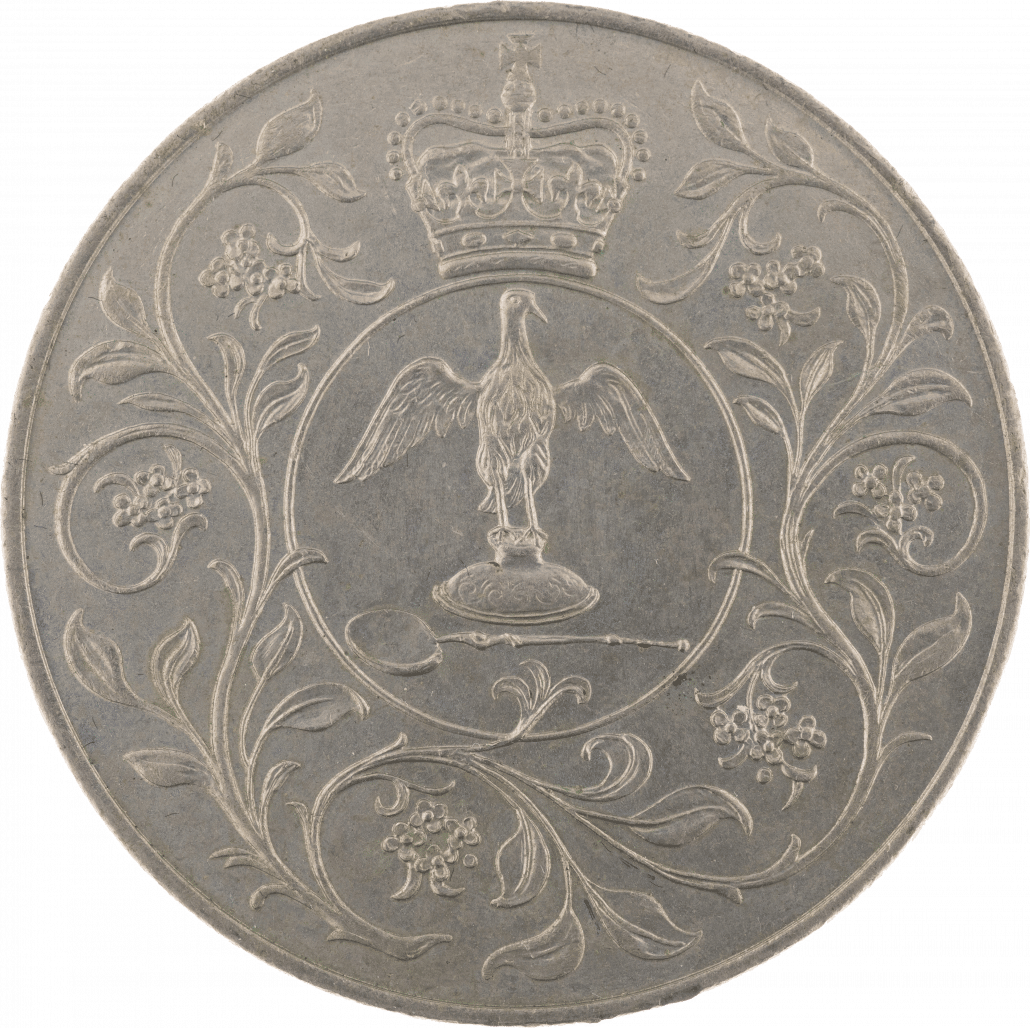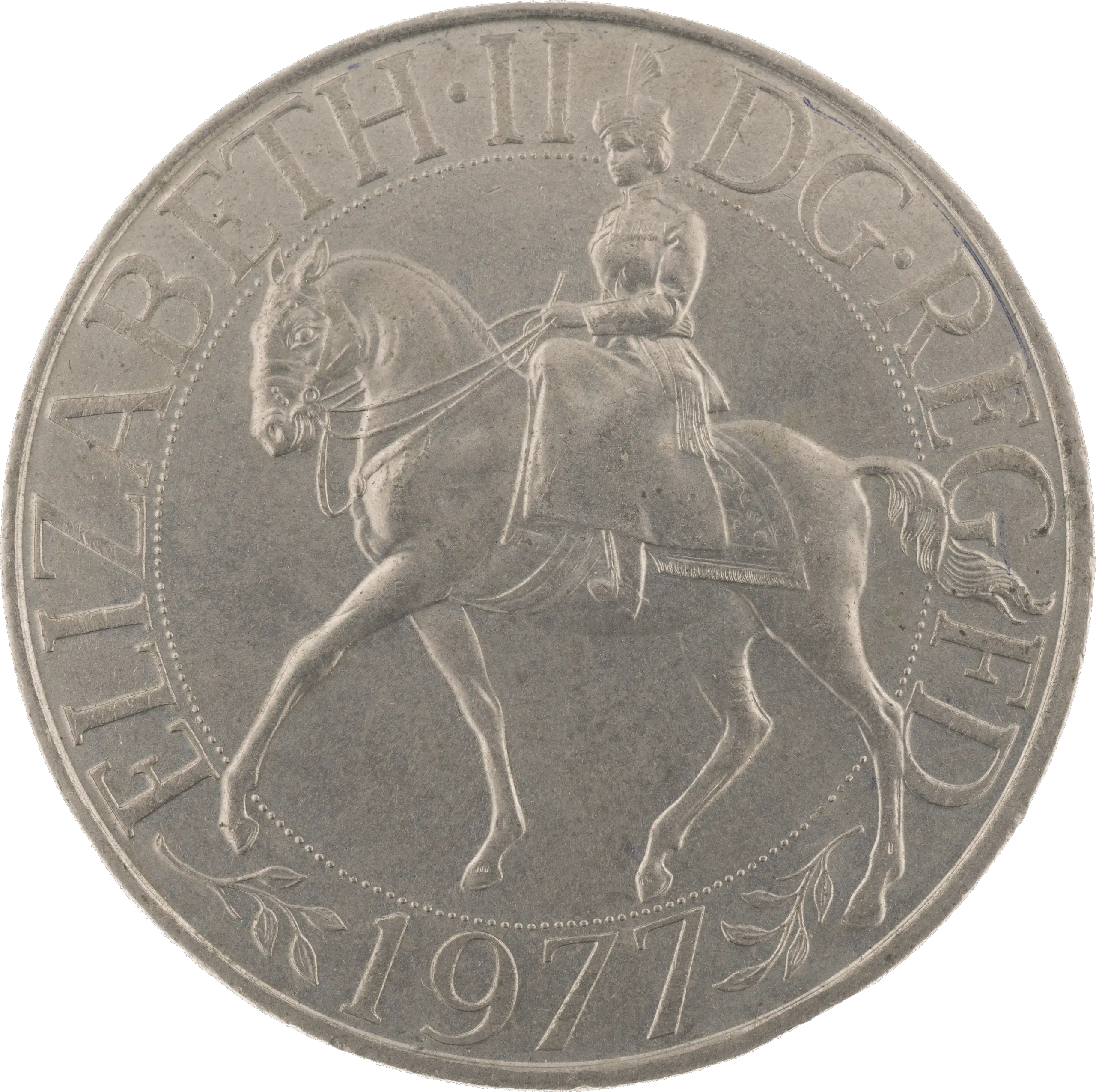If you’re in possession of a 1977 Jubilee crown, you’ll be eager to find out just how much they’re worth. Although these coins can be purchased relatively cheaply at the moment, there are certain factors that can increase their value.
On eBay, 1977 Jubilee crown coins sell for an average of £1.42. Silver proof versions are much rarer, however, and are usually listed between £30 and £60 at coin dealers.
In the rest of this article, we’ll cover the different versions of the 1977 Jubilee crown, as well as just about everything else there is to learn about this fascinating coin.
What Does The 1977 Jubilee Crown Look Like?
The 1977 Jubilee crown can be recognised by the depiction of Queen Elizabeth II on horseback on the obverse, or front side, of the coin. Surrounding this image is the inscription: ‘ELIZABETH II DG. REG FD 1977’.
On the reverse side of the crown, a decorative coronation insignia is present, although no inscription is visible.
Designed by renowned sculpture and artist, Arnold Machin, the coronation insignia shows the ampulla and anointing spoon used in Her Majesty’s coronation, with a crown atop and floral border framing them.


With a face value of 25p, the 1977 Jubilee crown could be, and was, used in commercial transactions.
However, many retailers were unwilling to accept the coin, which left owners with the option of paying it into a bank or Post Office or keeping it as a commemorative item. Notably, the value of the coin does not appear in its design.
How To Tell If Your Coin Is Real
If you want to verify that you have a genuine 1977 Jubilee crown, it’s important to look at the design closely. In addition to this, you’ll need to ensure that the size and weight of the coin are in keeping with the official figures.
The 1977 Jubilee crown is 38.61mm (3.83cm) in diameter, which makes it extremely noticeable. At 28.28g in weight, it’s much heavier than the modern coins that are in use today.
In addition to this, the coin has a milled edge, which you should be able to feel when you run your finger around the coin.
How Many Jubilee Crowns Were Minted?
36,989,000 1977 Jubilee crowns were minted and released into circulation, which means they’re not one of the rarest coins out there.
The silver proof version is much rare, however, and it’s estimated that just 377,000 of the silver crowns were minted, which explains their comparative rarity and higher value.
What Increases The Value Of A 1977 Jubilee Crown?
Like all coins, your 1977 Jubilee crown will be worth more if it’s in mint condition. If the coin has been well used, is damaged or marked in some way, this is likely to reduce its value.
As the 1977 Jubilee crown was produced as a commemorative coin, it was often issued in a case or box. Coins which are in mint condition and are still in their original box are likely to be the most valuable at all.
However, there are other factors that could increase the value of your 1977 Jubilee crown. In 2014, a 1977 Jubilee crown was presented at auction. Due to an error in the striking process, the design of the coin was off centre.
It was estimated that the coin would sell for £100-£150, which was significantly higher than a standard 1977 Jubilee crown would fetch, although the final selling price is unknown.
1977 Silver Jubilee Crown Silver Content
As mentioned earlier, there were two versions of the 1977 Jubilee crown minted. The cupronickel version contained no silver at all, whilst the silver-proof version was the one that contained silver.
The amount of silver in the silver proof 1977 Jubilee crown is 0.841 troy ounces of 0.925 sterling silver.
How To Tell If Yours Is Silver
It can be super tricky to tell the difference between the cupro-nickel and silver versions as they have the same dimensions.
The easiest way to tell the difference is with a certificate of authenticity that was issued with the silver versions. Aside from that, the silver proof version should be shinier and more metallic in appearance.
If you are still unsure you can contact your local coin dealer or jewellery store who should be able to provide some assistance.
Is The 1977 Silver Jubilee Crown Legal Tender?
As previously mentioned, the coin has a face value of 25p and is legal tender. It was not until 1980 that Crowns produced by the Royal Mint were changed to a face value of £5.
It does make much more sense to sell the coin, however, as it has much more value as a collectable coin than the face value that it represents.
Shops can also refuse to accept them anyway, due to the limited application of legal tender in day-to-day life, which makes it even less desirable to try and spend them. If you are still not certain about selling, then you can try a Post Office or Bank that would be likely to accept the coin.
Why Are Commemorative Coins Popular?
Commemorative coins are highly collectable for a number of reasons.
Firstly, they are only released to commemorate significant events, which means many people want to own them to celebrate or remember a notable moment in time.
In addition to this, commemorative coins are typically released as limited editions. With a restricted run, the rarity of the coin can drive up its value and make it more attractive to collectors.
Royal commemorative coins are always popular, with members of the public, amateur collectors and professionals. With numerous examples to choose from, the 1977 Jubilee crown is just one Royal commemorative coin that marks an important and historical societal event
Other Jubilee Crowns
The 1977 Jubilee isn’t the only coin that has been issued to commemorate a Jubilee.
The Golden Jubilee of 2002 was celebrated with a crown, for example, as was the very recent Platinum Jubilee in 2022. In fact, the Platinum Jubilee saw the largest coin ever produced by the Royal Mint which was sold to a private collector.
The Queen’s coronation, which marked the beginning of the Jubilee celebrations, was also commemorated with a Coronation Crown issued in 1953.
Final Thoughts
Although 1977 Jubilee coins might not be worth a fortune, it’s still worth keeping an eye out for the silver proof version which is substantially rarer.
If you’re interested in learning more about crowns check out our Winston Churchill Crown article or even the Diana and Charles Crown article.
